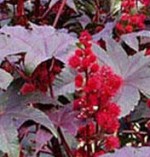 Castor bean is native to Africa, Middle East and India but has naturalized all over the world in subtropical and tropical areas where it can be found in disturbed areas such s roadsides and along railroads. It is a member of the spurge family (Euphorbiaceae, that also includes poinsettia, rubber tree, and cassava and is not a true bean. Growing up to 15-40’ tall in a single year, it quickly becomes a suckering shrub or small tree. Although a perennial in warm climates, castor bean is widely grown as an annual in cooler climates where it can add a tropical look to the landscape. In past years caster oil was used extensively as a laxative but is now commonly used as a lubricant and an ingredient in soaps, varnishes, and paints.
Castor bean is native to Africa, Middle East and India but has naturalized all over the world in subtropical and tropical areas where it can be found in disturbed areas such s roadsides and along railroads. It is a member of the spurge family (Euphorbiaceae, that also includes poinsettia, rubber tree, and cassava and is not a true bean. Growing up to 15-40’ tall in a single year, it quickly becomes a suckering shrub or small tree. Although a perennial in warm climates, castor bean is widely grown as an annual in cooler climates where it can add a tropical look to the landscape. In past years caster oil was used extensively as a laxative but is now commonly used as a lubricant and an ingredient in soaps, varnishes, and paints.
Description: Plants are well branched with watery reddish-purple stems that bear green, red, or variegated leaves. The leaves are palmately lobed, up to 30” across, and are borne on long petioles attached to the center of the leaf. In the Middle Ages the leaves were thought to resemble a hand so the plants were called “palma Christi”, “hand of Christ’. Male and female flowers lack petals and are borne in terminal panicles with female flowers at the top and male flowers below in mid- to late summer. The male flowers have conspicuous yellow anthers while the female flowers have conspicuous red stigmas. The fruit is a spiny ovoid capsule that explosively releases three flattened ripe seeds that resemble ticks.
Poisonous Properties: All parts of the caster bean plant contain the toxin ricin, a plant lectin that inhibits protein synthesis in the intestinal wall. Another lectin, ricinus agglutinin, coagulates and breaks down red blood cells. The most toxic part of the plant is the seeds and ingestion of 1-3 seeds by a child, or 2-6 by an adult, can be fatal. Symptoms of poisoning may not appear for several hours or a few day after ingestion and include burning of the mouth and throat, difficulty swallowing, nausea, vomiting, abdominal cramps, diarrhea, thirst, headache, dizziness, shock, lethargy, impaired vision, rapid heart beat, and convulsions. Internal damage may include internal hemorrhaging, fluid build up in the digestive tract and lungs, and deterioration of the liver and kidneys. Seeds that are swallowed whole may not cause harm because the seed coat is very hard and restricts the release of the toxin.